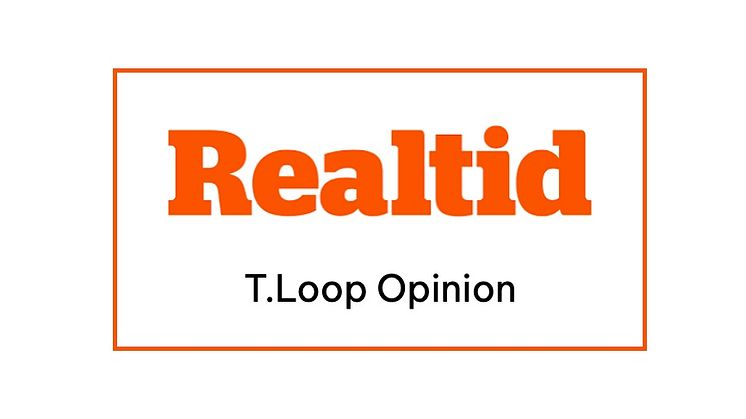
Blogginlägg -
Time for National Coordination to Drastically Reduce CO2 Emissions in Data Centers
This article was published by the Swedish newspaper Realtid, August 16th, 2023. (in Swedish)
We are in the midst of a digital revolution, with the rapid acceleration of artificial intelligence (AI), 5G, and the Internet of Things (IoT). This surge in technological advancement translates to an exponential increase in the volume of data we generate and manage. Consequently, there is a heightened demand for energy to power and cool data centers, which, in turn, contributes to the climate crisis. We have reached a critical juncture where we must balance the potential of technology with its environmental consequences. Hence, we call for a national strategy for coordinated and sustainable data management. This is authored by Staffan Stymne, CEO of T.Loop.
Data centers are at the core of our digitalization and should be treated as one of the most significant foundational industries of our time. Previous policy decisions, such as the removal of tax incentives for electricity in data centers, have not considered environmental goals. Data centers consume a substantial amount of energy and can strain the electricity grid.
We now advocate for central coordination in sustainable data management. To avoid increased carbon emissions from data centers, which currently account for approximately 1–2% of global electricity consumption, we must relocate servers to places where waste heat can be reclaimed and used to reduce the cooling energy requirement.
Data centers primarily consist of energy infrastructure to secure electricity supply and server and network cooling. Energy infrastructure and flows are often underutilized. With the right technology choices and design, the energy resources in data centers can be co-utilized to store and recover energy, thereby making a positive contribution to the energy and climate transition. Data centers, therefore, need not be a burden on either the energy transition or the climate; instead, they have excellent opportunities to become entirely energy-circular.
Additionally, data centers entail significant investments intended to last for 20-30 years. Therefore, it is crucial, in the face of burgeoning data growth, to make the right decisions so that we do not lock ourselves into a linear approach for such a critical societal infrastructure system.
AI technology is particularly energy-intensive due to the calculations required for training and data processing. However, AI has enormous potential to secure welfare and save the planet by reducing emissions and improving energy efficiency. According to the World Economic Forum, the global AI market could be worth $1.6 trillion by 2030. This underscores the immense pressure on data centers. For instance, in Denmark, energy consumption for data centers is estimated to triple by 2025 and account for approximately 7% of the country’s electricity use.
But there are solutions. The UK government’s net-zero emissions strategy document, published in 2021, highlights that waste heat from data centers can be used to heat homes and businesses. Countries such as Sweden, Denmark, Norway, Iceland, and the Netherlands have the potential to become leaders in this area.
Examples abound. In Frankfurt, several test projects harness waste heat from data centers to heat buildings. This reduces the need for fossil fuels for heating and, consequently, decreases CO2 emissions.
Another area with great potential is edge data centers. With increased demand for immediate data processing, such as in robotic operations, servers need to be as close to the execution as possible. This opens up opportunities to place servers in properties and reuse the generated energy for heating the building.
Data centers have a significant environmental impact and need regulation to ensure sustainability. We welcome forthcoming legislation on energy statistics reporting requirements to make the industry more transparent. However, given the rapid pace of technological and AI development, we believe more needs to be done. We want to see the following measures implemented:
- Develop a standard method for calculating the carbon footprint of data centers.
- Introduce requirements or policies to enhance data center efficiency and promote the use of waste heat, heat pumps, and energy storage.
- Demand energy performance in public procurement of data center and cloud services.
- Enforce reporting requirements for digital carbon footprint in sustainability reporting for publicly listed companies. Although the Corporate Sustainability Reporting Directive (CSRD) has been adopted by the EU, it is up to each member state to implement the directive at the national level.
- Improve energy planning to harness waste heat and synergistic effects.
Sweden can be a pioneer in utilizing waste heat and storage resources from data centers and make a real difference. We already have the technology, and other countries like Denmark, Norway, Iceland, and the Netherlands have also made significant progress. We must act now to ensure sustainable data management for the future and not compromise our planet.
Staffan Stymne CEO, T.Loop
Sources:
- Swedish Energy Agency, Energy Usage in Data Centers and Digital Systems (2023)
- World Economic Forum, “This is the AI balancing act: between its huge potential and growing emissions” (2023)
- Danish Energy Agency, Climate Status and Projection 2022 (KF22): Data Centers
- UK Government, Net Zero Strategy (2021)
- RISE, EU policies and its relevance to the circular transition of Swedish industrial companies (2023)

